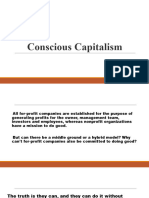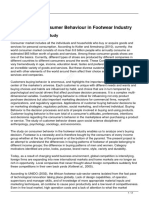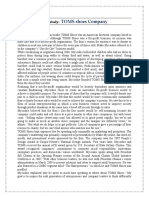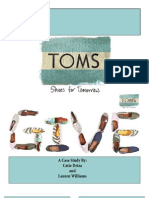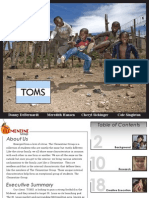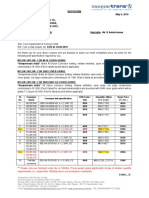Toms Shoes en
Toms Shoes en
Uploaded by
Harnantyo Amourmimi RamadhianCopyright:
Available Formats
Toms Shoes en
Toms Shoes en
Uploaded by
Harnantyo Amourmimi RamadhianOriginal Description:
Original Title
Copyright
Available Formats
Share this document
Did you find this document useful?
Is this content inappropriate?
Copyright:
Available Formats
Toms Shoes en
Toms Shoes en
Uploaded by
Harnantyo Amourmimi RamadhianCopyright:
Available Formats
TOMS SHOES: ETHICALLY GLOBAL?
The focus of most of the chapters in this text has been on companies seeking (or in many cases
failing) to operate according to clearly established ethical principles that guide how they treat
their stakeholders. The concept of doing the right thing has been presented as a natural
alignment to their central business purpose, whether thats making cars, computers, or providing
nancial or consulting services. But what about a company that was started speci cally to do
the right thing? Not a consulting company to advise other companies on ethical business
practices, but a company whose core purpose is conscious capitalismdelivering a product as
a means to another end. In 2006 Blake Mycoskie was inspired by a visit to Argentina to bring the
traditional Argentine alpargata slip-on shoe to the U.S. market. Not an unusual decision for a
serial entrepreneur like Mycoskie, but what made this idea unique was his purpose for this
business. While doing community service work in Argentina, Mycoskie was struck by the
countrys health and poverty problemsand in particular the large numbers of children without
shoes. His idea was to work with Argentinean shoemakers and vendors to produce shoes with
vibrant colors and prints for the U.S. market and to offer those genuine alpargata shoes at a price
point that would allow his company to give away one pair free for every pair sold. Mycoskie
originally intended to give 200 pairs of shoes to the children of Los Piletones in Argentina, but
the buy-one-give-one-away model proved so successful that the rst shoe drop, as the
donation visits have become known, delivered 10,000 pairs of shoes to match 10,000 pairs
purchased by customers at such retailers as Bloomingdales, Nordstroms, and Urban Out tters.
In the four years since Mycoskies company TOMS was founded, over 600,000 pairs of shoes
have been donated in Argentina, Haiti, and Ethiopia. The Ethiopian shoe drops are especially
signi cant because of a local disease called podoconiosis, a form of elephantiasis. Contracted
through the soil, the disease causes dis gurement and ulcers in the lower legs, and sufferers are
ultimately banished from their villages like lepers. The good news is that the disease is 100
percent preventable by wearing shoes, and the last Ethiopian shoe drop delivered 37,000 pairs.
An important point to remember when learning about TOMS is that this is a for-pro t company.
Mycoskie was inspired by the Newmans Own company started by actor Paul Newman and
writer A. E. Hotchner in 1982, which has donated over $300 million to community and healthrelated bene t programs in the last three decades. Newmans Own is also for pro t. The pursuit
of a favorable tax status as a nonpro t company was never the point; it was the ability to give
away the pro ts to worthy causesthats why the companies were created in the rst place.
1. Does TOMS buy-one-give-one-away model make it a more ethical company than a
traditional shoe manufacturer donating money to a charity? Why?
2. Why would customers pay such a high price for a simple linen shoe?
3. Mycoskie designed TOMS model from the ground up. Could an established company
improve its ethical standards by launching a model like TOMS? How?
4. Select two other industries that could copy the buy-one-give-one-away model, and
explain how it could be adopted.
You might also like
- Concious CapitalismDocument8 pagesConcious Capitalismisamad820No ratings yet
- SBNM 5992-A2: Strategy For Competitive Advantage Case Study Analysis #1: TOMS ShoesDocument7 pagesSBNM 5992-A2: Strategy For Competitive Advantage Case Study Analysis #1: TOMS ShoesJiaFengNo ratings yet
- A Study On Consumer Behaviour in Footwear Industry: Background of The StudyDocument3 pagesA Study On Consumer Behaviour in Footwear Industry: Background of The StudyLê Hồng NhungNo ratings yet
- Case - VEJA - Adaptado PDFDocument8 pagesCase - VEJA - Adaptado PDFGabriella Sant'AnnaNo ratings yet
- TOMS Shoes Company: Case StudyDocument3 pagesTOMS Shoes Company: Case StudyAnanya ChoudharyNo ratings yet
- TOMS Case StudyDocument14 pagesTOMS Case StudyLauren Conrad-Williams100% (9)
- TOMS Shoes Integrated CSR StrategyDocument12 pagesTOMS Shoes Integrated CSR Strategyhunter_abigail80% (10)
- TOMS Case StudyDocument12 pagesTOMS Case StudyLauren Conrad-Williams0% (1)
- By-Abivandya Anil Anoushka ChauhanDocument45 pagesBy-Abivandya Anil Anoushka ChauhanabivaandyaNo ratings yet
- Case Study - ToMS ShoesDocument8 pagesCase Study - ToMS ShoeshbchirwaNo ratings yet
- TOMS ShoesDocument2 pagesTOMS ShoesDavid SzalkaiNo ratings yet
- ABOUT TOM'S SHOES PresntationDocument2 pagesABOUT TOM'S SHOES Presntationpks94222No ratings yet
- Toms Shoes EthicsDocument8 pagesToms Shoes EthicsLekha GuptaNo ratings yet
- TOMS Case StudyDocument13 pagesTOMS Case Studycvd5061No ratings yet
- TOMS Case StudyDocument13 pagesTOMS Case StudyiammeganNo ratings yet
- Social Entrepreneurship AssignmentDocument4 pagesSocial Entrepreneurship AssignmentexplorewithpioneerNo ratings yet
- 5ec809db244c8ce377528562 - Tom's Shoes Business Case PaperDocument10 pages5ec809db244c8ce377528562 - Tom's Shoes Business Case PaperHasan PatowaryNo ratings yet
- Sotero 03performancetask StrategicmangementDocument4 pagesSotero 03performancetask Strategicmangementbernadette soteroNo ratings yet
- Toms Shoes - WikipediaDocument62 pagesToms Shoes - WikipediaJun Cyrell M. BolanioNo ratings yet
- Exercise for Chapter 5- TOMDocument7 pagesExercise for Chapter 5- TOMDuc ManhNo ratings yet
- Case Study - TomsshoesDocument2 pagesCase Study - TomsshoesPatrick SolomonNo ratings yet
- Adv Unit4 Lesson4cDocument3 pagesAdv Unit4 Lesson4cFatikun NajaNo ratings yet
- Case 4Document10 pagesCase 4gloria amandaNo ratings yet
- Best Guidance - Developing Global Business PlanDocument18 pagesBest Guidance - Developing Global Business Planivan jessicaNo ratings yet
- TOMS: Corporate Social ResponsibilityDocument7 pagesTOMS: Corporate Social ResponsibilityAndres EstupinanNo ratings yet
- TOMS PlansbookDocument36 pagesTOMS PlansbookLatonya Gutierrez100% (5)
- One For One The at of Giving at To TOMSDocument5 pagesOne For One The at of Giving at To TOMSnashat doosNo ratings yet
- Case AnalysisDocument3 pagesCase AnalysisAndrea Tuiza GonzalesNo ratings yet
- Wong Jian Huei 1001542665Document4 pagesWong Jian Huei 1001542665Wong Jian HueiNo ratings yet
- TOMS Case Study Aishath Shanasa 1191402196Document8 pagesTOMS Case Study Aishath Shanasa 1191402196BushraNo ratings yet
- TOMS Expands One For One Model To EyewearDocument2 pagesTOMS Expands One For One Model To EyewearevansNo ratings yet
- Assignment 1.hasan - CBDocument2 pagesAssignment 1.hasan - CBnoNo ratings yet
- Feasibility Study On How To Produce Canvas ShoesDocument20 pagesFeasibility Study On How To Produce Canvas ShoesPeter JohnNo ratings yet
- Bata Shoe Organization-OverviewDocument20 pagesBata Shoe Organization-OverviewMayank SharmaNo ratings yet
- TOMS Case StudyDocument8 pagesTOMS Case StudyayirafieroNo ratings yet
- Operations Management of Bata Shoes PakistanDocument17 pagesOperations Management of Bata Shoes Pakistancoolbouy8578% (9)
- Chapter - I: Consumer Towards Branded Foot Were &un Branded Foot WereDocument29 pagesChapter - I: Consumer Towards Branded Foot Were &un Branded Foot WeremohanakumarmbaNo ratings yet
- Summary - Do Something That MattersDocument17 pagesSummary - Do Something That MattersLaxmi PriyaNo ratings yet
- TomsfinalprojectpaperDocument15 pagesTomsfinalprojectpaperapi-352111965No ratings yet
- TOMS Report - Alizée RIBARIC - 20182109Document3 pagesTOMS Report - Alizée RIBARIC - 20182109Alizée RibaricNo ratings yet
- Gibi Shoes: Case StudyDocument7 pagesGibi Shoes: Case StudyNajera, Hazel Joy100% (1)
- Toms Corporate ResponsbilityDocument13 pagesToms Corporate ResponsbilityWhitley MarshallNo ratings yet
- Alen Jose Thomas - CSRDocument7 pagesAlen Jose Thomas - CSRAlen Jose ThomasNo ratings yet
- Market Research Report For Mexican Shoe Market/Emyco: Gajendra Sisodia GSODocument18 pagesMarket Research Report For Mexican Shoe Market/Emyco: Gajendra Sisodia GSOGajendra Singh SisodiaNo ratings yet
- Report On: - Buyology Team: - Southwest AirlinesDocument12 pagesReport On: - Buyology Team: - Southwest AirlinesPriya SrivastavNo ratings yet
- Hunter Garcia - Strategic Plan For TOMSDocument19 pagesHunter Garcia - Strategic Plan For TOMSAgustín MurgaNo ratings yet
- MPU Blake MycoskieDocument6 pagesMPU Blake MycoskieWenJun LeowNo ratings yet
- 10 Companies With Social Responsibility at The CoreDocument15 pages10 Companies With Social Responsibility at The CoreKathc AzurNo ratings yet
- A Comperhensive Study On in Footwear Industry With Special Reference To Bata India LimitedDocument50 pagesA Comperhensive Study On in Footwear Industry With Special Reference To Bata India LimitedshinysuganyaNo ratings yet
- Marketing Research BataDocument8 pagesMarketing Research BataHanyElSamanNo ratings yet
- Chapter 6 CaseDocument4 pagesChapter 6 CaseAbdulrehmanNo ratings yet
- Bata Shoe Organization Term PaperDocument26 pagesBata Shoe Organization Term PaperThowsin RahmanNo ratings yet
- Literature Review of Bata 02Document4 pagesLiterature Review of Bata 02Tanzil Islam100% (1)
- Toms Case Study 2Document3 pagesToms Case Study 2Ace ProductionNo ratings yet
- Ethics TomsDocument12 pagesEthics Tomsapi-337437376No ratings yet
- TomsDocument32 pagesTomsSreten Žujkić PenzionerNo ratings yet
- Toms Campaign Plan BookDocument44 pagesToms Campaign Plan Bookapi-317477536No ratings yet
- Ethical Chic: The Inside Story of the Companies We Think We LoveFrom EverandEthical Chic: The Inside Story of the Companies We Think We LoveRating: 2.5 out of 5 stars2.5/5 (8)
- Shoe and Leather Encyclopedia - A Book of Practical and Expert Testimony by Successful Merchants. Each Article a Chapter, Each Chapter a Single and Separate SubjectFrom EverandShoe and Leather Encyclopedia - A Book of Practical and Expert Testimony by Successful Merchants. Each Article a Chapter, Each Chapter a Single and Separate SubjectNo ratings yet
- Cost Comparison of Yarn Manufacturing in Different CountriesDocument3 pagesCost Comparison of Yarn Manufacturing in Different CountriesRezaul Karim Tutul100% (1)
- Indicative Bonds ListDocument4 pagesIndicative Bonds Listhinad419419No ratings yet
- Production-And-Operations-Management Solved MCQs (Set-3)Document8 pagesProduction-And-Operations-Management Solved MCQs (Set-3)Saif Ali KhanNo ratings yet
- AralPan9 q2 Mod10 Ang-Pamilihan-V5Document29 pagesAralPan9 q2 Mod10 Ang-Pamilihan-V5Wizly Von Ledesma TanduyanNo ratings yet
- GMV 263Document2 pagesGMV 263bashok20No ratings yet
- Impact of Covid On The Indian EconomyDocument7 pagesImpact of Covid On The Indian EconomyYogesh KadianNo ratings yet
- Amrit KaalDocument5 pagesAmrit KaalBhavya LumbhaniNo ratings yet
- Fundamentals of Accountancy, Business, and Management (FABM2) Notes ReviewerDocument3 pagesFundamentals of Accountancy, Business, and Management (FABM2) Notes ReviewerAngelNo ratings yet
- Bharti Airtel - Consolidated Balance Sheet Telecommunications - Service Consolidated Balance Sheet of Bharti Airtel - BSE: 532454, NSE: BHARTIARTLDocument2 pagesBharti Airtel - Consolidated Balance Sheet Telecommunications - Service Consolidated Balance Sheet of Bharti Airtel - BSE: 532454, NSE: BHARTIARTLrohansparten01No ratings yet
- Dialogue - 3: TASK 2.3 InteractionDocument2 pagesDialogue - 3: TASK 2.3 InteractionClaudia MacarieNo ratings yet
- Office Name Office Status Pincode Telephone No. Taluk (The Information Is Sorted District and Taluk Wise)Document58 pagesOffice Name Office Status Pincode Telephone No. Taluk (The Information Is Sorted District and Taluk Wise)Rishi WadhwaniNo ratings yet
- Chapter 7 International EconomicsDocument25 pagesChapter 7 International EconomicsTIRANo ratings yet
- Crop Compensation CalculationDocument3 pagesCrop Compensation Calculationprabhavmishra50No ratings yet
- ABLOY Handles A4 Catalogue WEB SinglepagesDocument24 pagesABLOY Handles A4 Catalogue WEB SinglepagesTamta ZakarashviliNo ratings yet
- Muhammad 'Ammar Afiq Bin Rahman - 2022764423 - Individual Report Isb566Document6 pagesMuhammad 'Ammar Afiq Bin Rahman - 2022764423 - Individual Report Isb566Mr. QuirkNo ratings yet
- Theories of International BusinessDocument6 pagesTheories of International Businessrgayathri16100% (2)
- Foreign Currency ValuationDocument15 pagesForeign Currency ValuationJeshmusicNo ratings yet
- GCIN1001 NotesDocument3 pagesGCIN1001 Notesjain pearlNo ratings yet
- Slavery in AmericaDocument3 pagesSlavery in AmericacharlesNo ratings yet
- India 5G SpectrumDocument24 pagesIndia 5G Spectrumaas.anushkaNo ratings yet
- 304FIN AFM Unit 2 Net Income ApproachDocument17 pages304FIN AFM Unit 2 Net Income ApproachKaran KacheNo ratings yet
- ReportDocument28 pagesReportNicolas Navarro ValenzuelaNo ratings yet
- Aarthik Sudharna - Marathi NotesDocument83 pagesAarthik Sudharna - Marathi Notessavanvkatkar7No ratings yet
- Af71b Garment Guide 2020Document23 pagesAf71b Garment Guide 2020bronicNo ratings yet
- Series IvDocument2,550 pagesSeries IvAmardeep KaushalNo ratings yet
- Checking Banknotes - UKDocument20 pagesChecking Banknotes - UKCassiane Ogliari100% (1)
- Coca Cola Vs Pepsi Financial AnalysisDocument44 pagesCoca Cola Vs Pepsi Financial AnalysisMihaela GheorgheNo ratings yet
- Maf551 Transfer PricingDocument43 pagesMaf551 Transfer Pricingfarah hanisahNo ratings yet
- Gyprex Brochure JAN2023Document2 pagesGyprex Brochure JAN2023TheEdgeNo ratings yet
- RIT IndividualDocument77 pagesRIT IndividualAngelica Pagaduan100% (2)
